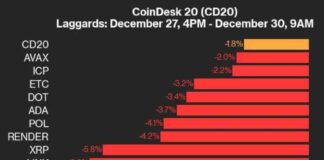In the world of finance, there are many misconceptions that often lead to misunderstandings. One common misconception is that traditional finance (TradFi) is highly centralized. However, the reality is that the global banking system is actually quite decentralized, with various national and regional entities playing a role in connecting it all together.
Another myth is that older technology is costly and prevents people from accessing banking services. In truth, high prices and limited access can often be attributed to burdensome regulations or a lack of competition, rather than the age of the technology itself. Mainframe transaction processing, for example, is both cost-effective and efficient, with many so-called “legacy” mainframes being relatively young in age despite running code that may be decades old.
While blockchains have been seen as a potential disruptor in the financial industry, there has been skepticism about their ability to replace traditional payment methods like credit cards and debit cards. This is due to the fact that older technologies boast superior performance, lower costs, and a large user base. However, what the blockchain sector may bring to the table is intense competition that could reshape the landscape of finance.
In theory, blockchains should not be more efficient than centralized systems for simple transaction processing, such as payments. This is because a blockchain duplicates payment data across multiple nodes, whereas a centralized system only processes the transaction once. A similar comparison can be made with telephone calls – the internet, despite its drawbacks, has become a dominant force in communications due to its affordability, availability, and competitive services.
Despite being less efficient in terms of transaction processing, blockchains are driving down costs and introducing new features at a rapid pace through intense competition and innovation. Blockchains like Solana, Aptos, and various Ethereum Layer 2 networks are significantly reducing transaction costs, with some transactions costing less than a penny. Internal research conducted by EY indicates that moving all financial transactions on-chain could result in annual savings exceeding $100 million.
While companies and individuals are slowly transitioning their transactions to the blockchain, there are still challenges to overcome. The emerging ecosystem of financial services on-chain, including payroll solutions like Franklin, offers lower costs than traditional providers. However, key features such as regulatory compliance, fraud prevention, and privacy are still lacking in blockchain technology.
Despite these hurdles, the programmable nature of blockchains allows for the addition of missing features, and advancements in technology make the implementation of these features more cost-effective each year. The next decade will be crucial in shaping the future of finance, akin to the transformation seen in the telecom industry with the rise of the internet and mobile technologies.
In conclusion, while the blockchain sector may face challenges in competing with traditional finance, the intense competition and innovation within the industry are driving down costs and introducing new features at a rapid pace. The future of finance lies in the ability to adapt to emerging technologies and embrace the changes that come with it.














